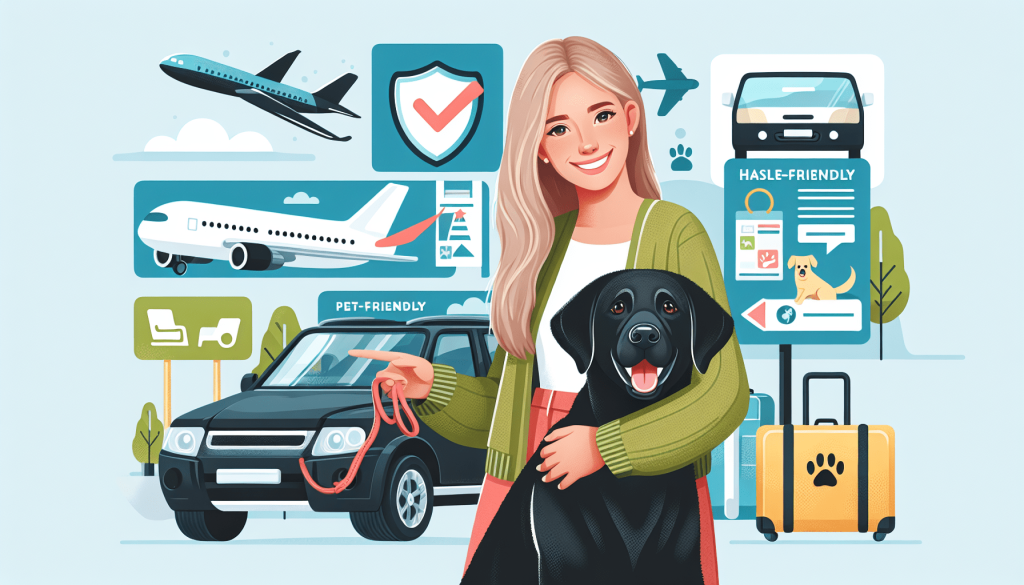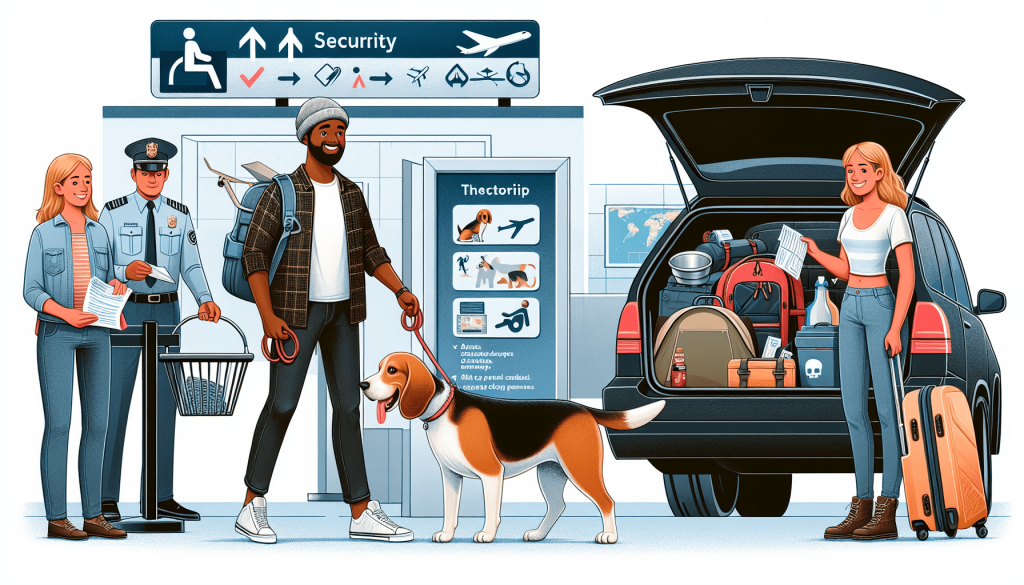Whether you’re planning a weekend getaway or a long road trip, taking your furry friend along can make the journey even more enjoyable. However, traveling with a dog requires some extra preparation and care to ensure a smooth and stress-free experience for both of you. From choosing pet-friendly accommodations to packing essential items, this article will provide you with helpful tips and tricks to make traveling with your dog a breeze. So, grab your pup’s leash and get ready for an adventure like no other!

Table of Contents
ToggleChoosing the Right Mode of Transportation
Consider Your Dog’s Size and Breed
When planning a trip with your furry friend, it’s important to consider their size and breed to determine the most suitable mode of transportation. Larger dogs may require more space and comfort, making cars or trains the better option. Smaller dogs, on the other hand, may be more comfortable in carriers for air or train travel. Additionally, certain breeds have specific needs and may require special accommodations. For example, brachycephalic (short-nosed) breeds often struggle with heat and may not be suitable for air travel during hot weather.
Check for Pet-Friendly Transportation Options
Before finalizing your travel plans, ensure that the chosen mode of transportation is pet-friendly. Many airlines, trains, and buses have specific rules and regulations regarding traveling with pets. Some may require advanced booking or specific documentation, so it’s important to research and confirm these details in advance. Opting for pet-friendly transportation will ensure a smoother journey for both you and your furry companion.
Research the Requirements for Traveling with Pets
Different modes of transportation and destinations often have specific requirements for traveling with pets. It’s crucial to research these requirements to ensure compliance and avoid any last-minute surprises. These requirements may include up-to-date vaccinations, health certificates, or specific forms to be filled out. By familiarizing yourself with these requirements, you can adequately prepare and make the necessary arrangements for a hassle-free journey.
Preparing for the Journey
Visit the Vet for a Check-Up
Before embarking on your journey, it is important to schedule a visit to the veterinarian. A thorough check-up will ensure that your dog is healthy and fit for travel. The vet can also provide updated vaccinations if needed and prescribe any necessary medications to keep your pet calm during the journey. This is also an excellent opportunity to address any concerns or questions you may have, allowing you to set off on your trip with peace of mind.
Ensure Your Dog’s Identification is Up to Date
Accurate identification is crucial when traveling with your dog. Make sure your pet is wearing a collar with an up-to-date ID tag that includes your current contact information. Additionally, consider getting your dog microchipped if they haven’t been already. In the unfortunate event that your dog becomes separated from you, proper identification greatly increases the chances of being reunited quickly. Taking these simple steps will go a long way in ensuring your dog’s safety during the journey.
Pack Essentials for Your Dog
When packing for your trip, don’t forget to include the essential items your dog will need. These may include food and water bowls, leash, collar, poop bags, any necessary medications, and a first aid kit. It’s also important to pack enough of your dog’s regular food to last the duration of the trip, as sudden changes in diet can upset their stomachs. Additionally, consider packing some familiar items such as blankets or toys to provide comfort and familiarity during the journey.
Ensuring Comfort and Safety
Invest in a Quality Crate or Carrier
Investing in a high-quality crate or carrier is essential for your dog’s comfort and safety during travel. The crate should be large enough for your dog to stand, sit, lie down, and turn around in comfortably. Proper ventilation is also crucial to ensure a good airflow. If you’re opting for a carrier, ensure it is well-padded and secure, providing a cozy and secure place for your dog to rest during the journey. Prioritize safety by choosing a crate or carrier that meets airline or transportation regulations.
Make the Travel Environment Familiar
Dogs thrive in familiar surroundings, so it’s important to make the travel environment as familiar as possible. Bring along your dog’s favorite blanket or bedding to create a sense of familiarity and comfort. Additionally, consider using pheromone spray or diffusers, which can help reduce anxiety and stress. By creating a familiar environment, you can help your dog feel more at ease during the journey.
Provide Adequate Rest Stops
Just like humans, dogs need regular breaks and opportunities to stretch their legs during travel. Plan your journey with regular rest stops to allow your dog to relieve themselves, get some exercise, and have a drink of water. Research pet-friendly parks or rest areas along your route to ensure you have suitable places to stop. These breaks are not only important for physical needs but also play a significant role in keeping your dog comfortable and happy throughout the journey.
Managing Your Dog’s Behavior
Train Your Dog for Traveling
Traveling can be a new and potentially overwhelming experience for your dog. Therefore, it’s important to invest time and effort in training them to be comfortable during travel. Start by familiarizing them with their crate or carrier and gradually increase the duration of time spent inside it. Reward your dog for calm and relaxed behavior to reinforce positive associations. Training will not only make the journey smoother but also ensure the safety and well-being of your dog.
Bring Familiar Toys and Comfort Items
Bringing along your dog’s familiar toys and comfort items can help alleviate anxiety and keep them occupied during the trip. Whether it’s a favorite stuffed toy or a chew toy, having familiar objects around can provide comfort and distraction. These items can also help redirect your dog’s attention if they start feeling restless or anxious. Familiar smells and textures can go a long way in keeping your dog calm and relaxed throughout the journey.
Use Calming Techniques if Needed
Even with proper training and familiar items, some dogs may still experience stress or anxiety during travel. In such cases, it’s important to have calming techniques in place. Playing soft, calming music or using pheromone sprays can help create a soothing environment. Additionally, consult with your veterinarian about potential natural or medication-based options to help calm your dog during the journey. Remember, it’s important to prioritize your dog’s comfort and well-being throughout the entire travel experience.
Feeding and Hydration
Stick to Your Dog’s Regular Feeding Routine
Maintaining your dog’s regular feeding routine is essential during travel to avoid any unnecessary digestive issues. Stick to your dog’s regular meal times as closely as possible, and avoid feeding them right before or during travel. If you’re on a long journey, it’s best to feed your dog at least a few hours before setting off. This allows time for digestion and minimizes the risk of stomach discomfort or motion sickness during the trip.
Bring Enough Food and Water for the Journey
Proper nutrition and hydration are crucial for your dog’s well-being during travel. Make sure to pack enough of your dog’s regular food to last the entire trip. It’s also a good idea to bring along some extra, just in case of any unforeseen circumstances. Similarly, carry an adequate supply of water for your dog, especially if you’ll be traveling through areas where access to clean water may be limited. Keeping your dog well-fed and hydrated will ensure their comfort and overall health throughout the journey.
Offer Water and Bathroom Breaks Regularly
Just like humans, dogs need regular access to water and bathroom breaks during travel. Offer your dog water at regular intervals, especially during rest stops or whenever they appear thirsty. It’s important to monitor your dog’s water intake to prevent dehydration, particularly in warm or humid climates. Additionally, make sure to provide opportunities for bathroom breaks every few hours to allow your dog to relieve themselves and stay comfortable.
Keeping Your Dog Entertained
Provide Interactive Toys and Treats
Long journeys can be tedious for both you and your dog, so it’s important to provide entertainment to keep them occupied. Interactive toys, such as puzzle toys or treat dispensers, can provide mental stimulation and keep your dog engaged. Fill these toys with their favorite treats or food to create a positive and rewarding experience. Interactive toys not only provide entertainment but also help alleviate boredom and potential anxiety during travel.
Play Games with Your Dog
Engaging in interactive games with your dog can make the journey more enjoyable for both of you. Whether it’s playing fetch at a rest stop or engaging in a gentle tug-of-war with their favorite toy, these activities can help burn off excess energy and stimulate their minds. Playing games also strengthens the bond between you and your dog, making the travel experience more positive and enjoyable.
Utilize Puzzle Toys for Mental Stimulation
In addition to physical activity and playtime, mental stimulation is essential for your dog’s well-being during travel. Puzzle toys that require problem-solving skills can keep your dog mentally engaged and help prevent boredom. These toys often involve hiding treats or requiring your dog to solve a series of puzzles to access their favorite snacks. Providing mental stimulation through puzzle toys will make the journey more enjoyable and help keep your dog entertained throughout the trip.
Adhering to Pet-Friendly Accommodations
Research and Book Pet-Friendly Hotels
If your journey involves overnight stays, it’s crucial to research and book pet-friendly accommodations in advance. Many hotels have specific rooms or designated areas for guests traveling with pets. Ensure that the hotels you choose have the necessary facilities to accommodate your dog comfortably. Whether it’s access to outdoor areas for walks or pet-friendly amenities, selecting the right accommodation will make your stay more pleasant and stress-free for both you and your furry friend.
Respect Hotel Rules and Clean Up after Your Dog
When staying at pet-friendly hotels, it’s important to respect the rules and guidelines they have in place. Follow any pet-specific guidelines, such as leash policies or designated pet areas, to ensure the safety of your dog and other guests. Additionally, always clean up after your dog, both inside the hotel room and in any common areas. This demonstrates responsible pet ownership and ensures a positive experience for everyone staying at the hotel.
Be Mindful of Other Guests
While you may be excited about your travels with your dog, not everyone may share the same enthusiasm. It’s important to be mindful of other guests when staying at hotels or other accommodations. Keep your dog’s noise level to a minimum, especially during quiet hours. Avoid leaving your dog unattended in the room, as barking or other disruptive behavior can be a nuisance to neighboring guests. By being considerate of others, you contribute to a positive experience for everyone involved.
Navigating Air Travel with Your Dog
Check Airline Policies and Restrictions
When considering air travel with your dog, it’s crucial to thoroughly research the policies and restrictions of the airline you plan to use. Airlines have specific regulations regarding pet travel, including size restrictions, breed restrictions, and specific crate or carrier requirements. Some airlines may also require additional documentation or a specific check-in process. By familiarizing yourself with these policies in advance, you can ensure a smooth and stress-free experience for both you and your furry companion.
Prepare Your Dog for Air Travel Conditions
Air travel can be stressful for dogs due to the unfamiliar sights, sounds, and confined spaces. To prepare your dog for air travel conditions, consider crate training and gradually increase the duration of time they spend in their crate. This will help them feel more comfortable and secure during the journey. Additionally, expose your dog to different noises and environments to desensitize them to potential stress triggers. These preparations will help your dog adapt better to the unique conditions of air travel.
Make Sure Your Dog’s Crate or Carrier Meets Requirements
To ensure a smooth journey by air, it’s important to make sure your dog’s crate or carrier meets the airline’s specific requirements. The crate should be sturdy, well-ventilated, and properly secured. Check the airline’s regulations regarding crate size, construction, and labeling. It’s also advisable to label the crate with your contact information and attach a photo of your dog. By adhering to these requirements, you can ensure that your dog travels safely and comfortably in the cabin or cargo area.
Staying Safe During Outdoor Activities
Use Leashes and Harnesses at All Times
When venturing into outdoor spaces during your journey, it’s crucial to keep your dog on a leash or harness at all times. Even the most well-trained dogs can be unpredictable in new environments, and using a leash or harness ensures that they stay safe and under your control. This is particularly important in areas with potential wildlife encounters or unfamiliar surroundings. By keeping your dog securely leashed or harnessed, you protect them from potential dangers and prevent them from getting lost.
Protect Your Dog from Extreme Weather Conditions
Weather conditions during your journey can vary, so it’s important to protect your dog from extreme temperatures. In hot weather, avoid prolonged exposure to the sun and ensure your dog has access to shade and plenty of water. Additionally, be cautious of hot pavement, which can burn your dog’s paws. In cold weather, provide your dog with appropriate coats or blankets to keep them warm. By being mindful of weather conditions, you can prioritize your dog’s comfort and well-being during outdoor activities.
Be Aware of Local Wildlife and Park Regulations
When exploring outdoor areas with your dog, it’s important to be aware of the local wildlife and any regulations or restrictions in place. Many parks and natural areas have rules regarding dogs, such as leash requirements or designated dog-friendly zones. Respecting these regulations ensures the safety of your dog, local wildlife, and other visitors. Additionally, be cautious of potentially dangerous wildlife and keep your dog away from any wildlife encounters. By being informed and responsible, you can enjoy outdoor activities with your dog while respecting the environment and local wildlife.
Being Mindful of Travel Etiquette
Consider Your Dog’s Behavior in Public Spaces
When traveling with your dog, it’s important to consider their behavior in public spaces. Not all people may be comfortable with dogs, and some may have allergies or fears. Keep your dog under control, obeying leash laws, and ensure they are well-behaved and socialized. Be mindful of other people’s personal space and comfort levels, respecting their boundaries. By being considerate and aware of your dog’s behavior in public spaces, you contribute to a positive experience for everyone you encounter during your journey.
Clean up after Your Dog
One of the essential responsibilities of a dog owner is cleaning up after your pet. Always carry waste bags with you and promptly clean up after your dog. This applies not only to public spaces but also to any accommodations or rest areas you visit. Properly disposing of waste helps maintain cleanliness and hygiene and shows respect for the environment and other people. By being a responsible pet owner and cleaning up after your dog, you can help create a positive image for fellow travelers who are also accompanied by their furry friends.
Respect Local Laws and Customs
When traveling to different destinations, it’s important to respect local laws and customs regarding dogs. Familiarize yourself with any specific regulations, such as leash laws or breed restrictions, and ensure compliance at all times. Be aware of cultural nuances regarding interactions with dogs, as attitudes and customs may vary from one place to another. By respecting local laws and customs, you demonstrate responsible and considerate behavior, leaving a positive impression on the communities you visit during your journey.
Traveling with your dog can be an enjoyable and memorable experience for both of you. By carefully considering and planning for each aspect of the journey, you can ensure your dog’s comfort, well-being, and safety throughout. From choosing the right mode of transportation to adhering to travel etiquette, each step contributes to a smooth and unforgettable adventure. So go ahead, pack your bags, and embark on a journey with your furry friend by your side!







